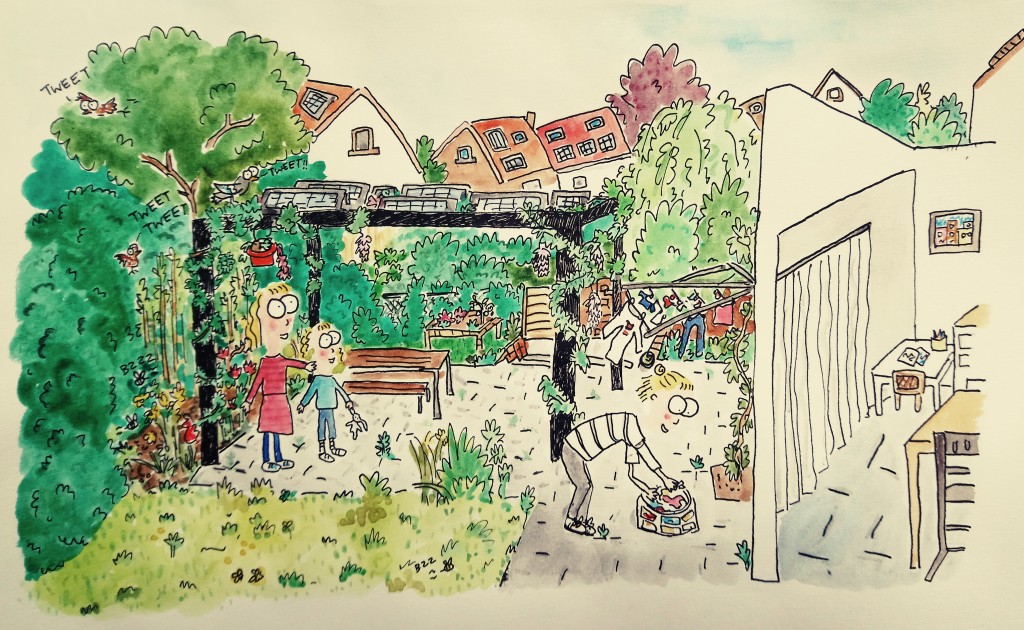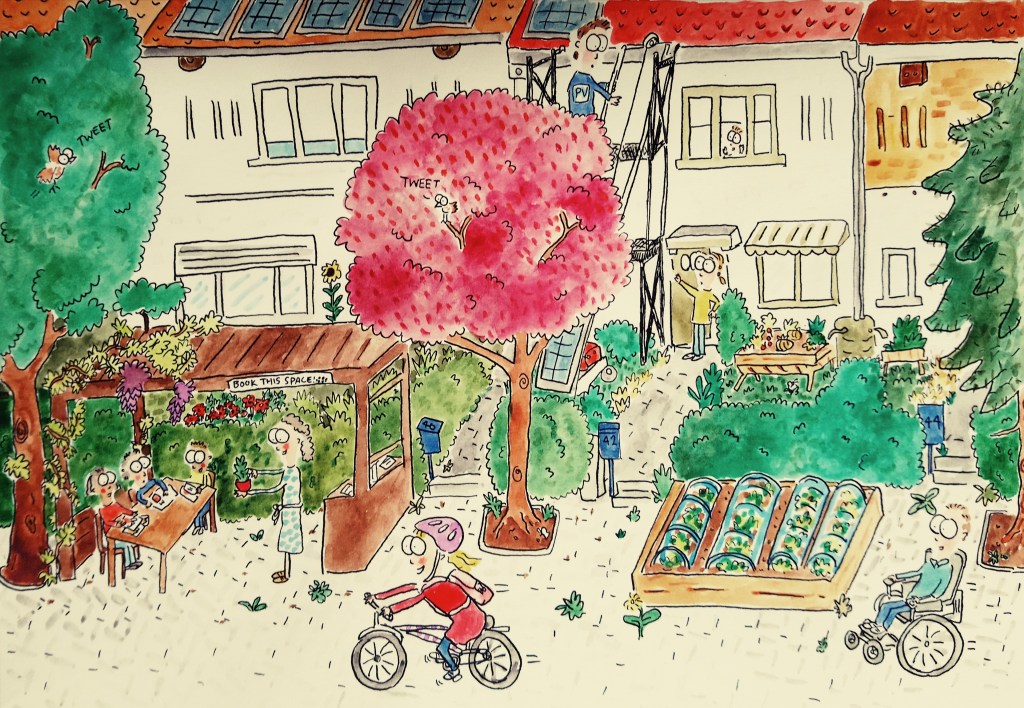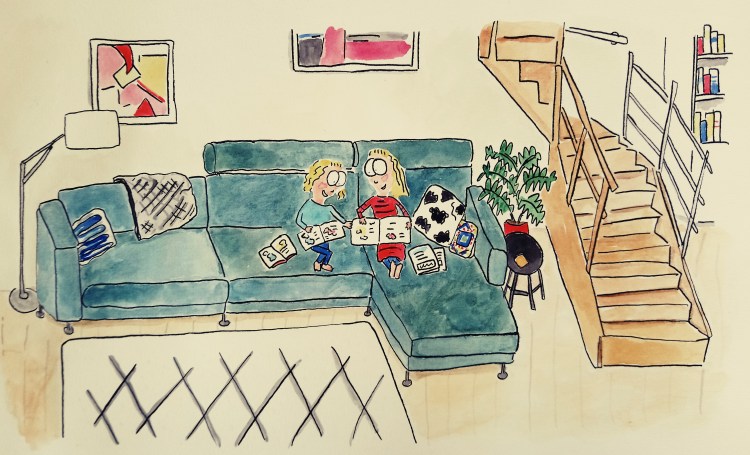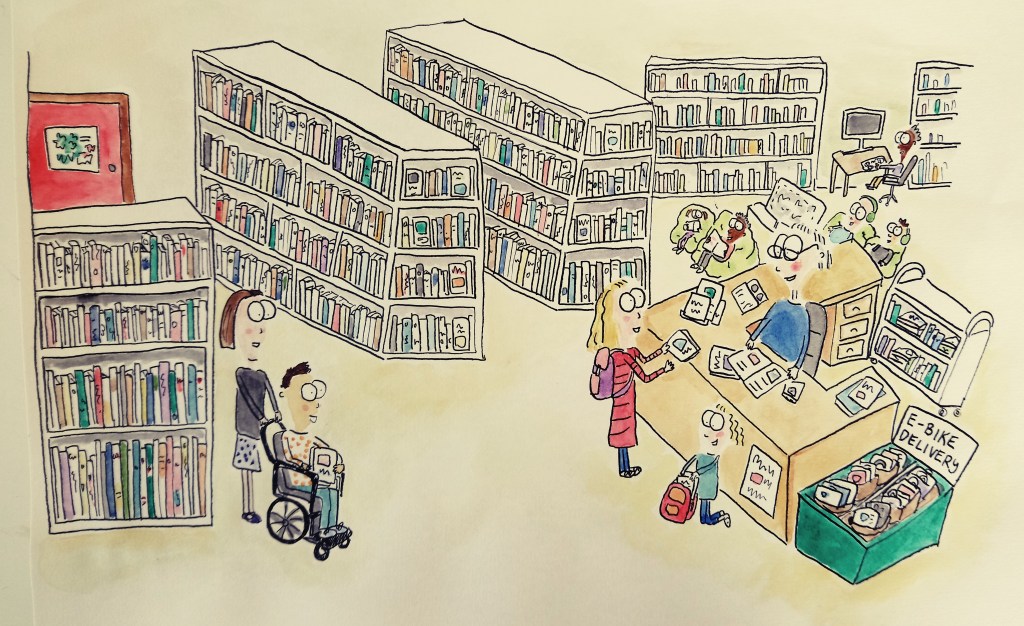I’ve been reading a lot of children’s stories over and over to our youngest daughter who’s now 22 months old and obsessed with books, so I’ve had a lot of time to look at the background pictures and the worlds the illustrators have created.
I especially love ‘The Baby’s Catalogue’ by Janet and Allan Ahlberg as it’s such a lovely glimpse into the recent past of parenting; the typical types of prams people had, the breakfasts they ate, the toys the children played with, the mum with her hair in curlers or the one washing her hair over the sink, and the dad loading up his pack lunch on his bicycle. The page with a picture of a washing line full of nappies being hung out to dry twists my heart every time. It used to be so normal to use reusable nappies and wash them, whereas now the equivalent picture of modern parenting would be one of a landfill site piled high with disposable nappies and drains clogged with wet wipes.
It gave me the idea of writing and illustrating a children’s book with pictures that would show the way we live but set in 2025 (THE FUTURE!), in a world where we have actually decided to do all the things we know will work and have the technology to do right now to reduce carbon emissions. (The first chapter of Rob Hopkin’s book ‘From What Is to What If’ has a lovely description of how he imagines his life in the near future which also inspired me).
I based my illustrations on our current house and neighbourhood as I imagine them looking in 4 years time, and tried to fit in as many clues as to the changes we will (hopefully!) have made by then into the details of the drawings as possible.
It’s a very simple story, it’s the tale of my two daughters at their future ages of 9 and 5 cycling and scooting by themselves to the local library and back, and who and what they see on the way:

“Yes, great idea! Go get ready and I’ll find your library cards for you.” said Mum.

“We will! Bye!” shouted the girls as they left.



“No we can’t, we have a music lesson in the square” replied Aimée

“Yes, great!” said the girls.

“I know!” shouted back Isabel.


“I can’t decide!” said Zala happily.

“No thank you, we can carry them ourselves.” replied Isabel.


The way of living I imagine in this story is the way I think we need to live to limit climate and ecological breakdown. (I’ve described the reasons why I think this in this blog post) In essence:
- Travelling by low carbon means (active travel, electrified public transport, shared electric vehicles, bicycles of all types, flights once or twice per lifetime if any, electric delivery and waste collection vehicles)
- Eating low carbon food (for the most part vegetarian/vegan, rationed meat consumption- beef/lamb once or twice per year, chicken and pork once or twice a month, locally grown, organic)
- Living in a single low carbon home (small and energy efficient, powered by renewable electricity with electrified hearing system/connected to local heat network, no second homes)
- Living by zero waste principles to minimise consumption and waste (no fast fashion, repair and mend, toy libraries, tool sharing etc)
- Doing a low carbon job (actively working to bring about low carbon lifestyles for everyone) or a socially necessary job that has been decarbonised as much as possible (e.g. working in the care industry, healthcare, education, food production etc in low carbon buildings and using low carbon energy efficient processes while applying zero waste principles). Those currently working in the fossil fuel industry will need to be retrained/work on the dismantling and repurposing of fossil fuel infrastructure.
- Four day working week (so that people have more time to care for children and elderly, grow food, participate in local community, repair and mend items, pursue low carbon leisure activities and hobbies)
*I’ve put ‘low’ carbon rather than an exact number for what we should be aiming for in each aspect of our lives as it’s difficult to quantify and will vary with local constraints, but the key thing to remember is we need to halt all emissions and have negative emissions AS SOON AS POSSIBLE to minimise the damage that we’ve already baked in. Given negative emission technology at the necessary scale just doesn’t exist yet, ‘low’ therefore means as close to zero as possible (this report has useful guidelines on per capita carbon emission targets to keep to only 1.5 degrees of warming).
This lifestyle is obviously going to come as more of a change if you are rich, which makes sense given the richest 10% responsible for half of world’s carbon emissions, but that doesn’t mean it will be a hardship, and that’s something I wanted to try and show in the story.
I think libraries which give people free access to shared resources and knowledge, and act as community hubs are key to how we need to shape the future. This is why I chose the local library as the destination point for the girls in the story, and haven’t changed much about the way it looks from the present day.


Dealing with the affects of climate change that are already unavoidable and have fallen and will continue to fall on the worlds poorest and least responsible for the problem most is obviously a huge issue. At the international and national level, with high local input, plans for areas which will need to be evacuated and areas which will need protecting from already baked in climate change issues will need to be developed so that internal and external migration levels can be handled (e.g. which coastal areas can be protected and which cannot, which whole regions are going to shortly become uninhabitable due to extreme heat or drought, which populations/communities need to be moved). Retrofit and new build projects will need to be targeted to areas that have been identified as having a viable future, and enable them to become more densely populated if necessary.
Our neighbourhood and the area that the girls cycle through in the story doesn’t face likely already unavoidable catastrophes from climate change (its not a coastal area and shouldn’t be affected by flooding/wildfires/drought), so I haven’t shown any preparations for a mass move out of the area in the story. It’s rather more likely that our area as a whole will need to become more densely populated than it already is. The parts of our neighbourhood pictured in the story however, are already quite densely populated. Our house is small (about 110 m2 for the four of us), and the particular streets that the girls cycle down to get to the library are composed of small to medium sized mainly terraced houses, with some small apartment blocks intermingled, so I haven’t shown any big changes in terms of building composition. I have tried to show that all the dwelling are occupied, as taxes and regulations will need to be structured so that having multiple homes is not be possible and empty properties can more easily taken into ownership by the state/community and renovated to be used for energy efficient social housing.
The many large, detached dwellings in our area that are not shown in the story may well need to become divided into small units/used to house multiple generations and/or their gardens made public and used for food production, park land, or to build new homes. Suburban sprawl is over!

I see this future as being over grown and somewhat scuffed and ramshackle – not ‘shabby-chic’ or ‘rustic’ as a desired Instagram aesthetic but genuinely worn round the edges as we switch to living by zero-waste principles and consuming far less. Clothes are worn till they fall apart and can no longer be repaired, children’s clothes and toys are handed down as many times as possible. Neighbourhood sharing/library schemes for tools and other items that aren’t used regularly are set up as are local repair café. I can imagine our garage (which we already converted into an art studio/bike shed- no way the car is being allowed in there!) being used as a local repair and mend workshop space.
Leaf blowers and other diesel/gas powered garden tools are no longer be allowed to be used, and hedge/tree trimming with electric tools is discouraged unless it affects road safety, which improves air quality, reduces noise pollution, increases biodiversity and provides cooling from plant cover. In my drawings I’ve tried to show how weedy and over-grown everything will look (instead of the usual sleek versions of the future we get shown).


Home retrofit programs are in the process of being rolled out so that existing homes can be made as energy efficient as possible, and can either make the switch to using electricity for heating or join local heat networks. Roof-top solar panels/solar hot water panels are being installed wherever possible, taking into account the need to plant more trees to line streets and provide shade during the summer that could over-shadow some rooftop installations.


The vast majority of private cars have been handed in and scrapped for metal and parts to make bicycles, trams and electric trains. Active travel- walking, scooting, cycling on normal bicycles and all kinds of electric cargo bikes to transport multiple people/children/disabled/elderly people/goods, has been prioritised alongside investment in public transport (electric buses, trams and metro system)so that nearly all journeys can be made via these methods. Charging infrastructure for electric delivery vans, rubbish collection vehicles electric buses and shared electric cars has also been put in place so all petrol/diesel vehicles can be removed from the roads.
These changes have freed up a huge amount of space that used to be necessary for parking. They can now be used for more greenery, tree-planting, food production, children’s play areas, outdoor gym equipment/games, outdoor seating, markets, cafe’s, teaching spaces, performance venues, bike storage, safe cycle lanes. This increased outdoor space to gather and socialize safely would make managing the ongoing Covid19 situation (and potential future pandemics) easier.
It’s also made the streets a lot safer for children to roam without the need for constant adult supervision.

All restaurants, cafes, take-aways, event catering businesses, work and school cafeterias now have to be vegetarian/vegan and everyone would have a monthly meat allowance whereby they can purchase only a certain amount of each type of meat per person per month. ‘Fake meat’ options are widely available, and experiments with eating insect protein have gained popularity.
To tackle plastic waste from take-aways, all restaurants in a decided upon zone use the same reusable storage containers, and there are regularly spaced collection units for these containers for customers to put them in once they have finished their meals and washed them out, and then they can be rewashed and distributed back to the restaurants.
As pet food is made mainly from the by-products of meat production for human consumption and this has been greatly reduced, the number of pets people are able to own has also been reduced – all puppy farms have been banned, all current pets have to be spayed and any cats owned as pets have to be kept indoors/on a leash outside as they kill so many small animals and birds which wreaks havoc on local biodiversity. Large gardens that have now been made public are used in some cases to raise chickens/goats and the increase in local biodiversity means people still have contact with animal life, and the increase in green space and reduction in dangerous motor vehicles has provided much more opportunity to safely socialize outdoors thereby reducing loneliness, so this is hopefully not the hardship that it may sound (sorry pet owners).

Regional airports have been closed, and the only airports that remain see radically reduced plane numbers taking off and landing each day (in the low double digits). All night-time flights (7pm -7am) are banned. Unused airport buildings have been turned into housing/offices/virtual reality hubs/conference spaces/markets/schools/play areas, and neighbourhoods around the airports have been completely rejuvenated given they no longer have to deal with air and noise pollution from flights.
Energy usage would have to be supply driven rather than demand driven as fossil fuel plants are shut down (and no new ones brought online) and the proportion of renewable energy increases. This would mean planning high energy use events around good wind/solar conditions. Weather forecasts would become known as ‘energy forecasts’ and public places would have screens displaying how much energy was likely to be available locally for the day/next day/week.

Home display screens showing how much energy is being used by each device/appliance and how much energy is available currently and in the near future based on the weather forecast and the homes energy generation capability, and how much is energy is stored in the homes battery capacity are becoming common in every home. In this way households can make decisions as to how and when they should use their appliances and charge up their devices.
For me, somebody in the richest 10% of the worlds population and quite possibly the richest 1%, I can see how this way of living could feel like a sacrifice. As a household we gave up air travel before coronavirus hit and made it even easier to do so, and I can’t say I miss it, but then we have two small children and so travelling to far flung destinations or going on city breaks is more of a nightmare scenario than dream experience anyway. We also live in a small house that we bought thinking we would only have one child and now we have two, and I can feel the temptation to build an extension. Not really because we need it, our daughter’s can hopefully share a room soon, but because that’s what society is telling me I need and should aspire to -a big house with a kitchen that looks just so with an island and stools and hanging light fixtures. How can I be happy with what we have? I must need more! A different outfit everyday! The latest electronics! A constant indoor temperature at all times that weirdly must be higher in winter than in summer! And giving up the car even though we are very lucky in that our neighbourhood has all the amenities we need in a fifteen minute radius by bike/foot, would still make reaching further flung leisure destinations and our extended family more difficult to get to as it’s a trek to get to a train station from us and tricky to pack light with small children.
But clean air, quiet skies and the freedom for myself and my kids to cycle safely and have a future not blighted by increased natural disasters, drought, food shortages, heat waves, biodiversity collapse, more pandemics is not something I or anyone (bar maybe billionaires with their bunkers in New Zealand) can afford so the benefits far far far outweigh the perceived sacrifices.
It’s going to be overgrown and messy and require more participation in our local communities than we’re used to and for us to change our rhythms depending on the weather, but I think our lives would be better.
Imagine!
Leave a comment